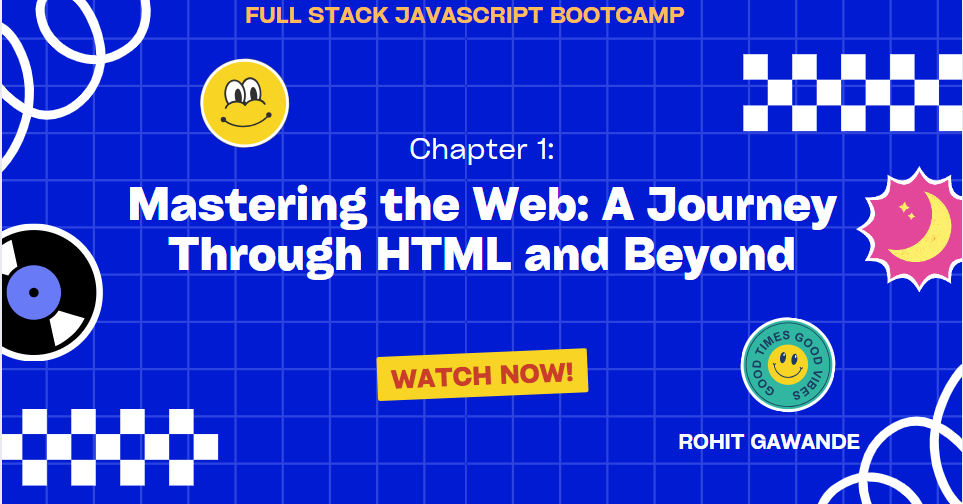Mastering the Web: A Journey Through HTML and Beyond
 Rohit Gawande
Rohit Gawande
History of HTML
HTML (Hypertext Markup Language) was first developed by Tim Berners-Lee in 1991. It was created as a simple way to structure and link documents on the web. The first version, HTML 1.0, was quite basic, supporting text formatting and links. Over time, HTML evolved through various versions (HTML 2.0, 3.2, 4.01) to include more complex features like tables, forms, and multimedia. HTML5, the latest version, introduced new elements, APIs, and improved support for multimedia, graphics, and responsiveness.
Web Server and Apache
A web server is a software that serves web pages to users upon request. It handles HTTP requests and sends back the appropriate content (like HTML pages, images, etc.). Apache is one of the most popular and widely used web servers. It is open-source and highly configurable, making it a favorite among developers.
What is Apache?
Apache HTTP Server, commonly known as Apache, is an open-source web server software that plays a key role in delivering web content. It was developed and maintained by the Apache Software Foundation. Apache is highly flexible, secure, and customizable, supporting a wide range of features like load balancing, URL redirection, authentication, and more. It's used by a significant portion of the world’s web servers.
Why index.html?
The file index.html is typically used as the default file served by a web server when a user accesses a directory. For example, if a user navigates to www.example.com, the server will automatically serve index.html if it exists in the root directory. This makes index.html the starting point or homepage of a website.
Emmet
Emmet is a powerful and widely-used toolkit that helps developers write HTML and CSS code faster by using abbreviations and shortcuts. It’s especially popular in code editors like Visual Studio Code, Sublime Text, and Atom. Emmet allows you to write out a concise code snippet, and then expand it into a full-fledged block of code, saving you a lot of typing and reducing errors.
More About HTML
HTML is a markup language used to structure and display content on the web. It consists of various elements represented by tags that define different types of content like headings, paragraphs, images, links, forms, etc. Understanding HTML is fundamental to web development.
Heading Elements
HTML provides six heading elements, <h1> through <h6>, used to define headings on a webpage. <h1> is the highest or most important level, while <h6> is the least important. They help in structuring content and are important for SEO (Search Engine Optimization).
Paragraph Element
The <p> element defines a paragraph in HTML. It is used to group text content into blocks that are typically separated by whitespace on the webpage. It is one of the most common and essential HTML elements.
Attributes
HTML elements can have attributes that provide additional information about an element. Attributes are always included in the opening tag and consist of a name and value pair, like class="example". They are used to customize the behavior and appearance of elements.
The Image Embed Element
The <img> element is used to embed images into a webpage. It requires the src attribute, which specifies the path to the image file, and alt, which provides alternative text for the image.
Attributes
For the <img> element, the key attributes include:
src: Specifies the path to the image.alt: Provides alternative text if the image cannot be displayed.widthandheight: Define the size of the image.title: Provides additional information that appears as a tooltip.
Live Server
Live Server is an extension commonly used in Visual Studio Code that allows you to run a local development server with live reload capability. When you save changes to your HTML, CSS, or JavaScript files, the browser automatically refreshes to reflect those changes. This is incredibly useful for web development, as it speeds up the process of testing and debugging code.
Subscribe to my newsletter
Read articles from Rohit Gawande directly inside your inbox. Subscribe to the newsletter, and don't miss out.
Written by
Rohit Gawande
Rohit Gawande
🚀 Tech Enthusiast | Full Stack Developer | System Design Explorer 💻 Passionate About Building Scalable Solutions and Sharing Knowledge Hi, I’m Rohit Gawande! 👋I am a Full Stack Java Developer with a deep interest in System Design, Data Structures & Algorithms, and building modern web applications. My goal is to empower developers with practical knowledge, best practices, and insights from real-world experiences. What I’m Currently Doing 🔹 Writing an in-depth System Design Series to help developers master complex design concepts.🔹 Sharing insights and projects from my journey in Full Stack Java Development, DSA in Java (Alpha Plus Course), and Full Stack Web Development.🔹 Exploring advanced Java concepts and modern web technologies. What You Can Expect Here ✨ Detailed technical blogs with examples, diagrams, and real-world use cases.✨ Practical guides on Java, System Design, and Full Stack Development.✨ Community-driven discussions to learn and grow together. Let’s Connect! 🌐 GitHub – Explore my projects and contributions.💼 LinkedIn – Connect for opportunities and collaborations.🏆 LeetCode – Check out my problem-solving journey. 💡 "Learning is a journey, not a destination. Let’s grow together!" Feel free to customize or add more based on your preferences! 😊